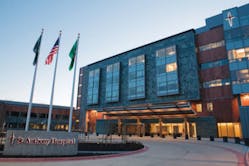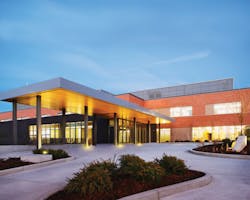Many hospitals and health systems are piloting mobile and digital technology projects, such as telehealth projects, to improve patient outcomes, enhance the patient experience and also with the aim of reducing health care costs. In many cases, these projects impact one service line, such as telehealth visits offered in the emergency room. At Tacoma, Wash.-based CHI Franciscan Health, clinical and executive leaders are going much broader and deeper to leverage health information technology to transform care delivery.
CHI Franciscan’s Care Transformation team launched in 2009 with a team of four people focusing on one small project, virtual urgent care, according to Lana Adzhigirey, R.N., program manager, Care Transformation, Virtual Health Services at CHI Franciscan. Today, that team has grown into a multi-disciplinary and multi-dimensional service line with more than 150 clinicians and IT professionals. What’s more, the initiatives that the Care Transformation team has implemented are resulting in significant positive impacts on patient outcomes, avoided healthcare costs and unprecedented system efficiencies.
As such, the project was awarded semifinalist status in this year’s Healthcare Informatics Innovator Awards Program.
The CHI Franciscan Health system, which consists of eight hospitals and a large network of physician clinics, has a mandate to redesign its healthcare delivery towards a value-based system serving the Pacific Northwest. The health system’s Care Transformation initiative is a massive project that is patient-focused in scope and has the dual benefit of added value to business and clinical outcomes. The Care Transformation team consists of a number of providers, nurses, information technology specialists, analysts and others roles and responsibilities, all of which focus around providing care to patients where they are, and eliminating any geographic, time commitment and language barriers in accessing that care, Adzhigirey says.
To date, the Care Transformation team has implemented a number of successful programs, most utilizing digital and mobile health technologies—virtual urgent care, post-discharge outreach, a virtual intensive care unit (ICU), virtual consultations with nurses and specialists, virtual diabetes education, regional telemetry monitoring program and a virtual inpatient companion program.
St. Anthony Hospital, Gig Harbor
Going back to 2009, the program had humble beginnings with its four-person team focused on the virtual urgent care project. “We started out with a telehealth initiative, and then we quickly realized that if we just work with technology and just implement technology, it doesn’t get us far. So, we redesigned our concept to include any and all programs across the care continuum for the patient so that we are working with people first, and technology second,” Adzhigirey says. “That has really blossomed into a large team that went outside of telehealth and we decided to call it Care Transformation.”
The team then focused on a virtual diabetes program to enable patients to use an app on their smartphones to interact with their diabetes educators for better diabetes management. The Care Transformation has since broadened the initiatives to both the acute care side and the outpatient side.
“We’re very focused on a multidisciplinary approach” Adzhigirey says. “In healthcare, it’s very easy to get siloed into either a service line or a specialty and even the acuity of the patient, so I think we are unique in the way that we want to make sure that we approach it as a multidisciplinary team. So, we have providers, we have nurses, we have some IT folks, we have program managers, so a variety of people.”
St. Elizabeth Hospial, Enumclaw
However, Adzhigirey notes that one challenge early on was building credibility around the program among clinicians, physicians and executive leaders “Telemedicine was brand new back then. So, we implemented it with our employees first, and our employees actually helped use that service and then talk about it so that word-of-mouth really helped to solidify that program and then spread it out to the community,” she says. Jessica Kennedy-Schlicher, M.D., now runs the virtual urgent care program as the medical director of the virtual and transformational health services line at CHI Franciscan Health.
The results of the Care Transformation team’s work, to date, have been very impressive:
- Virtual Urgent Care: As one of the first hospital systems in the U.S. to provide wide-scale virtual urgent care services, the health system has extended its full-spectrum primary care services to the public any time of day. Since its implementation, the virtual urgent care service has achieved a 95-percent patient satisfaction rate and saved over $1.5 million in health care costs and 10,511 hours of wait and travel time.
- Virtual Intensive Care Unit: This program is one of the few in the country that developed the software algorithms and hardware solutions in partnership with clinicians, according to Matt Levi, director in healthcare administration and innovation at Franciscan Health System and previously director of the clinical operations for the Care Transformation team and virtual health services. Within one year of operation, the nursing team handled more than 8,000 inquiries from the bedside clinicians with the volumes nearly doubling in the last two months (as of November 2016). In addition, the ventilator bundle compliance has improved by 17 percent points and is consistently staying at goal.
- Virtual Diabetes Education: Since its inception in 2012, 35 patients with diabetes have received high touch interaction and education from diabetes educators and have demonstrated sustained decreases in their Hgb A1C, have lost weight, stopped smoking and improved their activity levels.
- Regional Telemetry Monitoring: Franciscan Health was the first U.S. health system to utilize regional telemetry monitoring. In 2014, the team spearheaded patient heart monitoring across five hospitals, in order to observe heart arrhythmia and heart saturation levels so that nurses could immediately be tapped to check on patients who may be at risk for further cardiac monitoring. The regional telemetry monitoring has enabled CHI Franciscan Health to proactively monitor patients’ heart rhythms and rates for over 2 million hours and engage 24 patients in the first six months from the launch before cardiac issues occur. Due to its success, the health system expanded monitoring to two additional hospitals. Adzhigirey says the initiative has enabled an efficient, standardized way to communicate warning signs to the bedside clinicians and provided for expertise sharing of the monitor technicians who are monitoring from the same location.
- Virtual Companion program: Utilizing Microsoft Lync, the health system developed “virtual companions” to provide the same service as in-room patient “sitters,” or certified nursing assistants who sit with inpatients at the bedside to reduce falls. In the nine months since implementation, the companions have cared for 994 patients and nearly 50,000 hours of sitting. Preliminary results have shown a downward trend in patient falls in the units who participate in the Virtual Companion program compared to those who have opted out. For example, the last measured month, there were 4,270 hours of virtual sitting, participating units had a fall rate of 4.4 (falls per 1,000) versus 9.0 (falls per 1,000) in non-participating units at the same hospital.
- Virtual Pharmacy program: When a newly added clinic lacked the resources to employ a pharmacist, the Care Transformation team offered a virtual video solution which leverages the existing pharmacist across four clinics. The newest program, yet within the first week of implementation, the service improved medication compliance by including the patient in decision making.
What has been key to the Care Transformation team’s success with these IT initiatives? First, the programs were developed at the grassroots level, and built around the patients’ needs, Kennedy-Schlicher says.
“We center all our work around the patient. And, we always come from the point of view from a patient—if you are sick, if you are in the hospital, or outside of the hospital, even before you get sick, how do you access the system What are some challenges to go through the health care system? We all know how complex is, our goal is to take it to the next level. We are serving the patient, so the patient is at the center instead of the health care at the center, as if health care is at the center, then patients are left with trying to find their way through the system to get what they need,” Adzhigirey says.
And while IT is foundational to most of these initiatives, in many ways, the projects improved patient outcomes because the technology enhances a patient’s engagement with their own care and enables physicians to provide a high level of care. With the virtual diabetes program, the diabetes educators were able to form a relationship with patients and communicate frequently. If the diabetes educator received an alert about a patient’s high blood sugar level, then the educator contacted the patient right away. “This just-in-time learning led to behavior changes as the constant communication kept the patients motivated,” Adzhigirey says.
St. Joseph Medical Center, Tacoma
Along with clinical outcomes, the initiatives have had an impact on business outcomes as well by increasing efficiency and streamlining processes. Previously, all eight hospitals in the system had their own telemetry monitoring programs and those were combined into the regional telemetry monitoring program. “We found in that process that a lot of the telemetry units had varying standards and safety checks and processes around notifying the nurses and physicians, so we streamlined those processes and, ultimately, made care safer for patients,” she says.
Health systems looking to replicate the Care Transformation team’s work should first build a passionate team, Adzhigirey says. “Have your champions with the same goal in mind,” she says, and adds that health system leaders should look at leveraging IT, especially in the area of care coordination and analytics, to help monitor and manage large patient populations. “With CMS [the Centers for Medicare & Medicaid Services] metrics tying more reimbursement to the control of A1C and blood pressure, it has to be done in a way that clinical resources are deployed effectively and that requires technology to be better around the patient.”
Kennedy-Schlicher adds that physicians want to provide excellent care, “it’s their number one driver,” so they have an interest in technology that enables that. Technology such as virtual consultations enables a multidisciplinary team of clinicians and physicians to work together to care for a patient, which mirrors what happens at the bedside. “We use telemedicine in the Key Free Clinic (Key Peninsula, Wash.) where I work and it’s an asset. There is nursing expertise that physicians need, and to have access to that to improve the quality of care dramatically, that’s a unique asset and any physician would love to have a consultant that they could ask, such as about medication administration,” Kennedy-Schlicher says.
As the health system continues its care transformation journey, the work is not without its challenges. The cost of a technology is a hurdle, as is reimbursement for telemedicine, although many payers are catching up, the team members say.
“As our health environment goes from the traditional fee-for-service environment to a more value-based environment, there’s no way you can do population health and scale it without telemedicine, and so I think every health system has that movement to make a transition,” Kennedy-Schlicher says. “We are constantly thinking about keeping the patient at the center, as any industry would do, having your customer at the center is going to be the key. And, we’re figuring out how to do that.”
“We got lucky that one executive that had a passion around [the program.] However, even eight years later, we’re still fighting that fight,” Adzhigirey says. “There’s still varying opinions about telehealth and this program on its own as some people understand it and some people need to be educated about it, almost on a daily basis. We’re continuing to champion this program because we know how important it is.”





